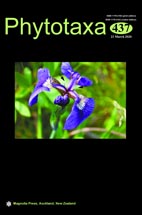Abstract
Xanthagaricus siamensis, a new species in the family Agaricaceae, was discovered in northern Thailand and is here introduced based on its morphological features and molecular data. It is characterized by small to medium-sized basidiomata, a convex to plano-convex with depressed center pileus when mature, the presence of greyish orange to violet-brown fibrillose squamules on the pileus, lamellae that start out white, change to pinkish white when damaged, then change to dull green with age. Additionally, the annulus is fugacious, and the pileipellis is recognized as a cutis which morphologically distinguishes it from all other known Xanthagaricus. Phylogenetic analysis of the internal transcribed spacer region (ITS) and the large subunit of the nuclear ribosomal DNA (nrLSU) sequence data indicated that the three specimens of X. siamensis form a distinct lineage within Xanthagaricus, and they formed a well-supported clade representing the genus Xanthagaricus. Detailed illustrations of macro- and micro-morphological characteristics and descriptions are provided, as well as other relevant molecular evidence.

